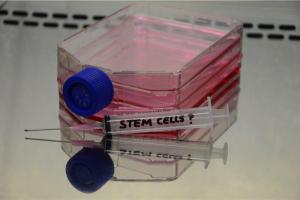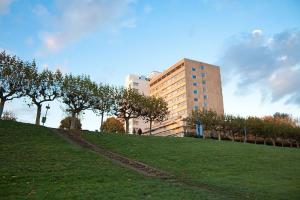Stem cell tourism: selling hope through unproven stem cell treatments - lessons from the X-Cell Center controversy
 by Casimir MacGregor, Alan Petersen, Megan Munsie
by Casimir MacGregor, Alan Petersen, Megan Munsie
In recent years there has been a growing interest in so-called stem cell ‘tourism’ - where a person (often companied by their carer/family) travels to another country for a purported stem cell treatment that is not available in their home country. Many advertised treatments are clinically unproven, with little or no evidence for their safety and efficacy in specific conditions. The majority of treatments marketed as ‘stem cell treatments’ are autologous cellular therapies: stem cells are taken from the patient’s own body and re-injected into the patient’s own body to promote regeneration. Some clinics also claim to use donated cord blood, or embryonic and fetal cells, but it is hard to know what is being administered to recipients and difficult to scientifically verify.
Over the last couple of years, we have been capturing the experience of Australians who have embarked on journeys in the pursuit of stem cell treatment. Participants in our research project have travelled overseas for treatments for various conditions including spinal cord injury, cerebral palsy, motor neurone disease and multiple sclerosis. Common destinations are China, India, Germany, Israel, the United States of America and Panama.
The X-Cell Center
One of the early destinations of choice was the now infamous X-Cell Center that operated in Cologne and Düsseldorf in Germany. The X-Cell Center clinic was established in early 2007 by Cornelis Kleinbloesem, a Dutch entrepreneur with a background in pharmacy and clinical trials research. The creation of the X-Cell Center in Germany was in part due to new regulation by the Dutch government, which in 2006 introduced a moratorium banning unproven stem cell treatments and created new regulations concerning the differentiation of stem cells and a requirement to have a license for stem cell transplants. The new regulation took effect on 1 January 2007, stifling some of Kleinbloesem’s earlier business interests. By establishing the X-Cell Center clinic in Germany Cornelis Kleinbloesem was able to take advantage of a loophole that existed in German law due to a transition period that required European compliance standards to come into effect.
Capitalizing on stem cell hype
During its period of operation (2007-2011) the X-Cell Center treated many thousands of people, almost exclusively foreigners from various countries. Much of the success of the X-Cell Center was due to its ability to tap into the expectation surrounding stem cells. It capitalised on this global hype by selling stem cell treatments for some of the most debilitating conditions. According to the X-Cell Center website they offered to treat a myriad of conditions including diabetes, stroke, spinal cord injuries, multiple sclerosis (MS), cardiovascular disease, Parkinson’s disease, Alzheimer’s disease, amongst others.
Their website featured stories proclaiming ‘miracles’ of the power of stem cell treatments, such as a story of a former patient who was cured of diabetes[1]. The clinic was open about the treatment procedures - described in some detail on their website - but it is difficult to determine the level of risk that was elaborated to patients as many patients had different experiences. But in selling stem cell treatments the clinic did seek to downplay the risks associated with autologous stem cell treatments, stating: “The XCell-Center only uses ethically inoffensive adult stem cells for treatment and research”.
Patient experiences at The X-Cell Center
 A key factor in the X-Cell Center’s success was the setting of its operations. By renting floors in Catholic Hospitals, such as the Dominikus Hospital in Düsseldorf-Heerdt (pictured right), the clinic conveyed the impression of offering an ethically uncontentious treatment.
A key factor in the X-Cell Center’s success was the setting of its operations. By renting floors in Catholic Hospitals, such as the Dominikus Hospital in Düsseldorf-Heerdt (pictured right), the clinic conveyed the impression of offering an ethically uncontentious treatment.
Visitors and patients alike have reported the clinic’s opulent reception area and the selling of a premium service, with treatments priced from 3,000 to 10,000+ Euros. But one of the biggest selling points for X-Cell Center was ‘brand’ Germany—relying on the country’s international reputation for high medical and manufacturing standards. As a participant in our research stated, going to Germany meant that they “felt reassured about what was happening as opposed to being in a [third world country]”. The experience of going to the X-Cell Center for treatment was sold as a tourist event, with patients being met at the airport or train station by a representative and accompanied to the clinic and offered transfers to and from the patient’s hotel.
Clinics such as the X-Cell Center exploit those vulnerable and in search of hope. Former patients have recounted their suspicions about the X-Cell Center. One research participant recalled their experience of treatment at the clinic:
I went into the room. The thing that did get me a little bit suspicious when I got there was they took my money straight away, which I think’s a little bit odd but, then again, I can understand that people are coming from overseas…and then, basically, they did the procedure the following day.
Another former patient also explains their experience:
When I was hooked up to the drip, before they injected the stem cells in, the manager of the place, a great, huge guy came out and he said, “Oh we haven’t got a receipt for the money,” so I had to make sure the money had gone into their account before they would put the stem cells in. On my return [to Australia]…my neurologist sent me to a haematologist and got my bloods checked, and he said there’s no evidence whatsoever to say that I have had a stem cell transplant.
These comments are just some from former patients; however, they suggest a business driven by money more than patient welfare.
Adverse events close the X-Cell Center
In 2010 the X-Cell Center came under increasing criticism when a 10 year old boy from Azerbaijan suffered severe internal bleeding in the brain after he was given treatment that involved injecting stem cells into the brain, and the death of an 18 month old from Italy who died from complications relating to a similar procedure. Following these adverse events, German regulators were able to close the X-Cell Center since subsequent investigation found that intra-cranial injections with blood cells produced more harm than benefit; further, there was no data to support X-Cell’s use of this treatment. The majority of the X-Cells Center’s patient data was generated by questionnaires administered via email or telephone rather than via scientific clinical methods. Therefore, in early 2011 the X-Center was instructed to adhere to new regulations in Germany that would require special application for continued therapies. Due to the issues outlined above, they were unable to obtain compliance. Later in 2011 the X-Cell Center filed for insolvency because German authorities denied the clinic further authorisation for stem cell transplantation.
But another clinic opens…
Not long after the closure of the X-Cell Center, Cornelis Kleinbloesem opened another stem cell treatment clinic called Cells4health in Beirut, Lebanon - again operating via a regulatory loop-hole, offering the same experimental stem cell therapies offered by the X-Cell Center, and again charging many thousands of dollars to vulnerable patients. This clinic is an international operation - it takes autologous cells from the patient’s bone marrow in the clinic in Beirut and then sends them to the UK’s Precious Cells laboratory for processing. Then the stem cells are sent back to Lebanon and injected into the patient. It would appear in this case that despite the lack of credible evidence to support the serial activities by Kleinbloesem, patient demand in the face of regulatory ambiguity or vacuum have allowed this concerning and potentially risky intervention to continue.
Lessons from X-Cell
We can learn several things from the controversy surrounding the X-Cell Center. First, there is a need for enforced advertising standards that limit the health claims that can be made about experimental therapies such as autologous stem cell treatments. Second, the public needs more information about stem cell interventions - and autologous stem cell treatments in particular - to limit risks posed to patient welfare. Third, regulation can be used as a tool to shut down clinics using questionable clinical techniques. And finally, the issue of borderless health care, especially for experimental therapies that exploit vulnerable patients, could be described as a human rights issue. We'll return to this last point in a later post.
Notes and acknowledgements
- The authors are currently involved in a research project, titled High hopes, high risks: a sociological study of stem cell tourism, funded by the Australian Research Council (DP120100921).
- [1] www.xcell-center.com/news - The X-Cell Center website was accessed via the web archive: http://web.archive.org/
- Syringe image by Arun T Konattu
- Hospital image by Solches (Own work) [CC BY-SA 3.0], via Wikimedia Commons
- Thanks to Ira Hermann of Stem Cell Network NRW for reviewing this article.
- Edited by Kate Doherty